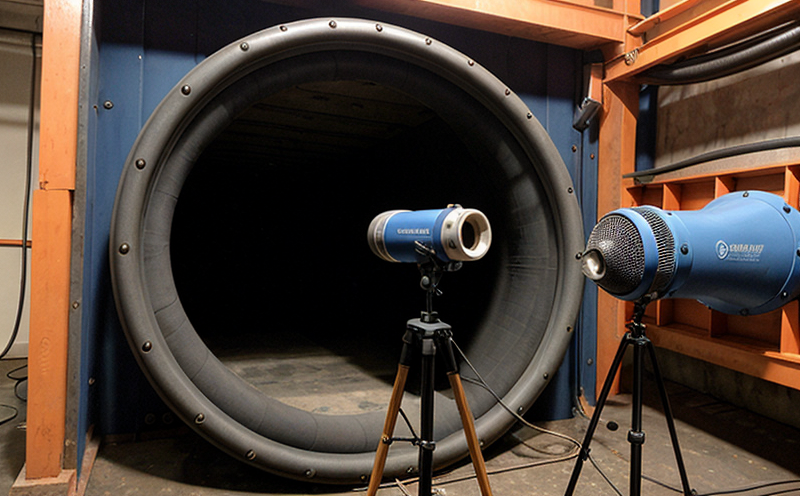ISO 16810 General Principles of Ultrasonic Testing Precision and Accuracy Evaluation Test
ISO 16810: This international standard provides general principles for the precision and accuracy evaluation of ultrasonic testing (UT). It establishes a framework to evaluate the reliability and consistency of UT results, which is essential in industries where material integrity is critical. The standard applies across various sectors including aerospace, automotive, construction, and manufacturing.
The core objective of ISO 16810 is to ensure that ultrasonic testing meets specified precision and accuracy criteria through standardized methods. This ensures the reliability of UT results by minimizing measurement errors due to environmental factors or operator variability. The standard covers essential aspects such as test setup, calibration procedures, data acquisition, and evaluation techniques.
Ultrasonic Testing (UT) is a non-destructive testing method used extensively in quality control and assurance processes. It involves the use of high-frequency sound waves to detect internal flaws within materials or components without causing damage. UT is particularly effective for inspecting metals, ceramics, composites, and other conductive materials.
The precision and accuracy evaluation test outlined in ISO 16810 aims to assess the performance of ultrasonic testing equipment and operators. This involves a series of controlled tests that mimic real-world conditions but are designed to provide repeatable results under standardized circumstances.
These tests help identify potential sources of variability in UT measurements, allowing for corrective actions to be implemented. By adhering to ISO 16810 guidelines, laboratories can ensure they meet stringent quality standards and maintain industry compliance.
The evaluation process typically includes:
- Calibration checks
- Data collection under controlled conditions
- Analysis of test results against predefined acceptance criteria
- Evaluation of operator performance through standardized procedures
Through these steps, ISO 16810 ensures that UT results are reliable and consistent across different environments and operators. This is crucial for industries relying on ultrasonic testing to ensure product safety and quality.
The standard also emphasizes the importance of maintaining accurate records throughout the evaluation process. These records serve as a reference point for future audits, training programs, and continuous improvement efforts within laboratories.
By following ISO 16810 guidelines, organizations can enhance their reputation by demonstrating commitment to high-quality testing practices. This is especially important in sectors where material integrity plays a critical role in product performance and safety.
Benefits
Adhering to the principles outlined in ISO 16810 brings numerous benefits to laboratories conducting ultrasonic testing:
- Improved Reliability: By standardizing test procedures, ISO 16810 ensures consistent and reliable results.
- Enhanced Accuracy: The evaluation process helps identify and mitigate sources of measurement error, leading to more accurate UT results.
- Increased Efficiency: Standardized protocols reduce the time needed for initial training and ongoing calibration, streamlining operations.
- Better Operator Training: ISO 16810 provides a structured framework that aids in the development of skilled personnel capable of performing precise UT.
- Compliance Assurance: Following this standard ensures compliance with international quality standards and regulatory requirements.
The benefits extend beyond internal processes, impacting broader industry practices. Laboratories that adhere to ISO 16810 contribute to the overall reliability and safety of products across various sectors, fostering trust among customers and stakeholders.
Moreover, by participating in precision and accuracy evaluations according to ISO 16810, laboratories enhance their credibility within the competitive market landscape. This is particularly important for gaining new clients and maintaining long-term relationships with existing ones.
Customer Impact and Satisfaction
The application of ultrasonic testing in accordance with ISO 16810 has significant positive impacts on customer satisfaction and trust:
- Informed Decision-Making: Customers can rely on the precision and reliability of UT results, leading to more informed purchasing decisions.
- Increased Confidence: Compliance with international standards like ISO 16810 instills confidence in customers regarding product quality.
- Better After-Sales Support: Laboratories demonstrating adherence to such rigorous standards can offer enhanced after-sales support, addressing any concerns promptly and efficiently.
Customers expect consistent performance from suppliers, especially those involved in critical applications where material integrity is paramount. ISO 16810 helps meet these expectations by providing a transparent and reliable testing process.
The standard also supports long-term relationships through its emphasis on continuous improvement. This demonstrates a commitment to maintaining high standards over time, which is crucial for sustainable business practices.
In summary, ISO 16810 plays a vital role in enhancing customer trust and satisfaction by ensuring the reliability and accuracy of ultrasonic testing results. This supports broader industry goals related to product safety and quality assurance.
Competitive Advantage and Market Impact
- Enhanced Reputation: Adherence to ISO 16810 enhances a laboratory's reputation, making it more attractive to potential clients.
- Differentiation: By offering services that meet stringent international standards, laboratories differentiate themselves from competitors.
- Better Client Relationships: Meeting the requirements of ISO 16810 fosters stronger client relationships through consistent and reliable service delivery.
- Innovation Support: The structured approach provided by ISO 16810 facilitates innovation within laboratories, driving advancements in UT techniques.
The market impact of adhering to ISO 16810 is substantial. It contributes to the overall reliability and accuracy of ultrasonic testing across industries. This ensures that products and materials meet stringent quality standards, thereby reducing defects and failures in end-use applications.
By maintaining high-quality UT services aligned with international standards, laboratories can contribute positively to global industry trends towards enhanced product safety and performance. This is especially relevant in sectors where regulatory compliance plays a crucial role.
The standard also supports the development of new technologies and methodologies within ultrasonic testing. Through continuous evaluation and improvement processes mandated by ISO 16810, laboratories stay at the forefront of technological advancements, positioning themselves as leaders in their respective fields.





